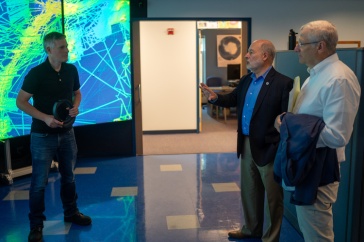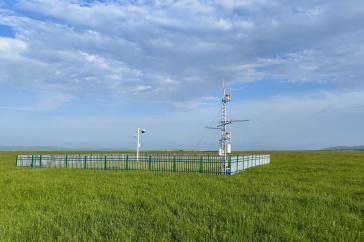
Artist's depiction of Solar Orbiter exploring the sun's realm. © ESA/AOES.
Since the dawn of the space age, scientists and engineers in the UNH Space Science Center have been highly successful designing and building instruments for satellites that help solve fundamental mysteries of the universe and push the bounds of discovery forward.
This has led to a heritage of in-house expertise and the ability to craft similar instrumentation for successive missions with related science goals. Indeed, a telescope currently being developed for the Solar Orbiter mission is based on one built at UNH and currently aboard NASA's twin Solar-Terrestrial Observatory (STEREO) spacecraft.
The Solar Orbiter telescope will do work similar to its predecessor but under much more stressful conditions. Being a mere 21 million miles from the sun (that’s 71,960,000 miles closer than is Earth), the instrument will have to sweat it out in a region where spacecraft temperatures reach 500 degrees Fahrenheit, squint at light 13 times more intense than at Earth, and withstand highly energetic particles able to go through metal as if it was butter.
"That's one of the biggest challenges for this mission," says research professor Antoinette Galvin, who leads the UNH team developing the Ion Composition Time-of-Flight/Energy Telescope that will be part of the Heavy Ion Sensor. The work is being done under a $4.67 million subcontract from the Southwest Research Institute (SwRI)—lead institution for the sensor aboard the joint European Space Agency/NASA mission. Professor Lynn Kistler is a co-investigator and responsible for making sure all UNH hardware is designed to meet mission science requirements.
The UNH telescope is not an optical telescope but, rather, a detector that can measure individual particles. It's at the very heart of the mission because it will measure—closer to the source than ever before—the particles that explode directly off the sun to create the million-mile-per-hour solar wind, which in turn creates "space weather"—the constant stream of energetic particles that can pose intense radiation hazards to satellites, astronauts, and transpolar aircraft crews.
"Most of the orbiter's instrumentation will be behind a state-of-the-art heat shield nearly a foot thick, but because we have to look directly at the sun and measure these particles, part of our telescope will actually reside in an area cut from the main heat shield specifically for this purpose," says Galvin.
The instrument, in other words, will occupy the hot seat for the entire seven-year mission. A miniature heat shield will afford additional protection, but the telescope aperture must be fully exposed to the elements. Galvin adds, "This is new territory as far as radiation and heat and even just the photo flux, or how brilliant it will be. The closer you are to the sun, the more intense it gets in terms of the number of particles, and we have to worry about the lifetime of our detector because the very thing we measure can destroy it."
|
Mark Popecki inspects a prototype particle detector in a Space Science Center cleanroom. Photo by Kristi Donahue, UNH-EOS. |
Close in to "pristine" particles
Solar Orbiter, which is set to launch in 2017, will address today's central heliophysics question: how does the sun create and control the heliosphere—the immense magnetic bubble containing our solar system, solar wind, and the entire solar magnetic field.
To uncover the mysteries, direct measurements of the solar wind plasma (a gas of charged particles), fields, waves, and energetic particles have to be made close enough to the sun so that they are still relatively pristine. Moreover, the spacecraft needs to find a perch at least 30 degrees above the ecliptic plane in which the planets orbit the sun—and where the majority of spacecraft are located and make observations—because plasma, particles, and processes can come from regions at high latitudes before getting pushed down to the ecliptic.
Says Galvin, “By the time we see the solar wind it has been processed and changed by interactions in space, and one thing we’re trying to uncover is how the solar wind originates and is released. Being closer in and higher up with Solar Orbiter, we should be able to more clearly pinpoint what part of the sun is releasing the solar wind in the first place.”
To get into an orbit above the ecliptic plane, the spacecraft will do a series of Venus fly-bys over a period of years using the planet's gravity to hurl itself ever closer to the sun and achieve progressively higher latitudes.






















































